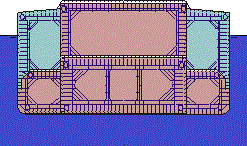The Coulombi Egg Oil Tanker - Ballast Tanks - Key to Safety Better protection, safer and more economical than Double Hull

|
 |
|
Start
page |
|
|
|
The only solution is re-coating but how to do that? Future repairs and maintenance of the coating are not easy, as access and space inside the double hull are limited by hundreds of manholes and the areas involved are very large. No doubt the coating will first break down in the highly stressed areas, local corrosion will start, fatigue or corrosion cracks develop and then anything can happen, e.g. the side shell falls off with a massive oil spill as a consequence. One weakness of Double Hull is that the outer side shell supports the inner shell and vice versa and that fractures in one may cause collapse of the two. Latest findings show that Double Hull crude oil tankers also need coating protection against pitting and corrosion in the bottom of the cargo tanks! The reason for this is multiple: sulphuric acid or biological matters concentrated in the water in certain crude oils that accumulates at the bottom, high temperature inside the double hull heating up the cargo oil, elastic deformation of the inner bottom plate up to 10 mm between stifferners and floors, crystaline modifications of the steel in way of welding butts and seams, etc. With no protection the result has been catastrophic - the pitting rate may be 2-3 mm per year on the cargo side, after three, four years the pitting has eaten through half the bottom plate, which then splits - oil fills the double bottom! Thus you have to add 15 000-20 000 m² of sophisticated coating of the cargo tanks bottom to the above in a double hull VLCC. No doubt the risk of structural failure, wear
and tear in the ballast space, and therefore also
the risk of leaks of cargo and hydrocarbon gas into
the ballast space, explosions and fires, are
reduced - and the safety is improved. The
single hull cargo bottom plate does not need any
inside corrosion or pitting protection based on
single hull experience.
Contact anders.bjorkman@wanadoo.fr
|